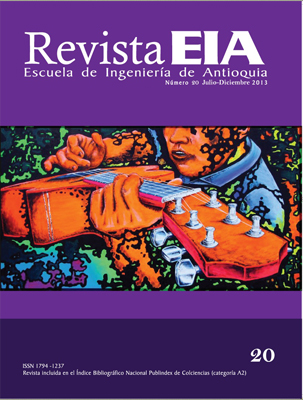COMPORTAMIENTO ESTRUCTURAL DE PUENTES EXTRADOSADOS DURANTE CONSTRUCCIÓN POR VOLADIZOS SUCESIVOS (STRUCTURAL BEHAVIOR OF EXTRADOSED BRIDGES DURING CANTILEVER CONSTRUCTION)
COMPORTAMIENTO ESTRUCTURAL DE PUENTES EXTRADOSADOS DURANTE CONSTRUCCIÓN POR VOLADIZOS SUCESIVOS (STRUCTURAL BEHAVIOR OF EXTRADOSED BRIDGES DURING CANTILEVER CONSTRUCTION)


This work is licensed under a Creative Commons Attribution-NonCommercial-NoDerivatives 4.0 International License.
Copyright statement
The authors exclusively assign to the Universidad EIA, with the power to assign to third parties, all the exploitation rights that derive from the works that are accepted for publication in the Revista EIA, as well as in any product derived from it and, in in particular, those of reproduction, distribution, public communication (including interactive making available) and transformation (including adaptation, modification and, where appropriate, translation), for all types of exploitation (by way of example and not limitation : in paper, electronic, online, computer or audiovisual format, as well as in any other format, even for promotional or advertising purposes and / or for the production of derivative products), for a worldwide territorial scope and for the entire duration of the rights provided for in the current published text of the Intellectual Property Law. This assignment will be made by the authors without the right to any type of remuneration or compensation.
Consequently, the author may not publish or disseminate the works that are selected for publication in the Revista EIA, neither totally nor partially, nor authorize their publication to third parties, without the prior express authorization, requested and granted in writing, from the Univeridad EIA.
Show authors biography
Este artículo presenta el estudio del comportamiento durante construcción por voladizos sucesivos de un puente extradosado en concreto de tres luces (60+100+60 m), modelado numéricamente mediante elementos finitos en el software SAP2000. La fluencia y contracción del concreto, al igual que los efectos P-delta, se incluyeron en el modelamiento. El estudio se concentró en el comportamiento del tablero, los cables y los pilares, durante construcción y desde el momento del cierre hasta cincuenta años después, tiempo en el cual han ocurrido los efectos diferidos. Los resultados encontrados permiten vislumbrar la importancia de la consideración de estos efectos en el análisis por etapas del puente. Por ejemplo, en el tablero ocurren variaciones considerables en fuerzas internas y desplazamientos en el tiempo, y en los cables tiene lugar una pérdida de tensión máxima del 10 % con respecto a la tensión al final de construcción. En los pilares, los efectos diferidos en el tiempo causan desplazamientos horizontales de magnitud considerable en la corona, generando momentos flectores excesivos en la base. Lo anterior obliga a introducir una fuerza durante la construcción de la dovela de cierre para corregir dicho fenómeno.
Abstract: This paper presents the results of the study of the structural behavior during cantilever construction of a concrete,
three-span (60+100+60 m) extradosed bridge, numerically modeled using a finite element model developed in the software SAP2000. Creep and shrinkage of concrete, as P-delta effects were taken into account. The study focuses on deck, extradosed cables and piers behavior, during construction, and from the time when the bridge is closed until fifty years, at which time all differed effects have taken place. It was possible to glimpse the importance of considering the
differed effects over time in the staged-construction analysis of the bridge. For example, considerable variations in forces and displacements were found in the deck, while a 10% tension loss in extradosed cables occurs. In the piers, differed effects introduce large horizontal displacements at the top which generate excessive bending moments at the bottom. This fact makes it necessary to apply a force during the construction of the closing segment to correct such phenomenon.
Sumário: Este artigo apresenta o estudo do comportamento durante construção por ressaltados sucessivos dum ponte extradorso em concreto de três luzes (60+100+60 m), modelado numéricamente mediante elementos finitos no software SAP2000. A fluência e contração do concreto, da mesma forma que os efeitos P-delta, incluíram-se no modelamento. Este estudo concentrou-se no comportamento do tabuleiro, os cabos e os pilares, durante construção e desde o momento do fecho até cinqüenta anos depois, tempo no qual aconteceram os efeitos diferidos. Os resultados encontrados permiten vislumbrar a importância da consideração destos efeitos na análise por etapas do ponte. Por exemplo, no tabuleiro acontecem variações consideráveis em forças internas e deslocamentos no tempo, e nos cabos tem lugar uma perda de tensão máxima do 10% com respeito à tensão ao final de construção. Nos pilares, os efeitos diferidos no tempo causam deslocamentos horizontais de magnitude considerável na coroa, gerando momentos flectores excessivos na base. O anterior obriga a introduzir uma força durante a construção da aduela de fecho para corrigir este fenômeno.
Article visits 470 | PDF visits 375
